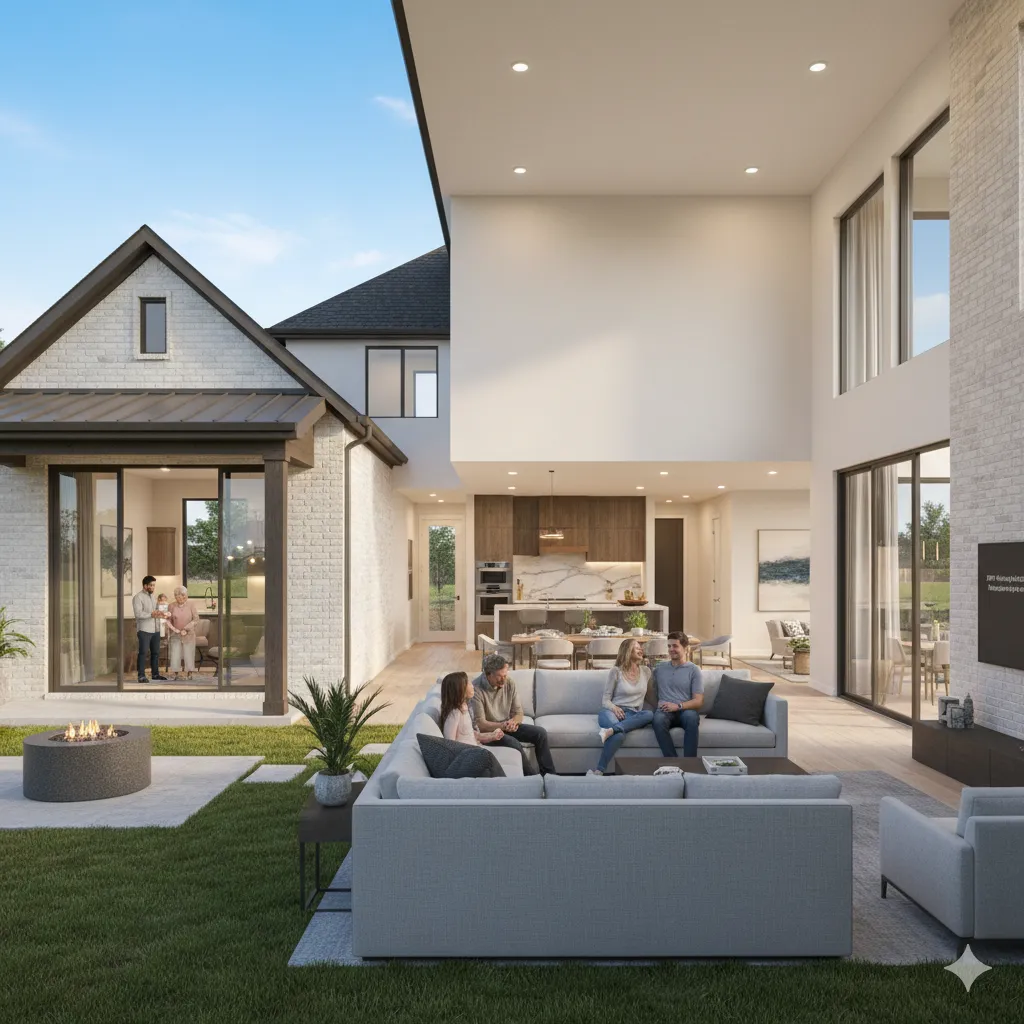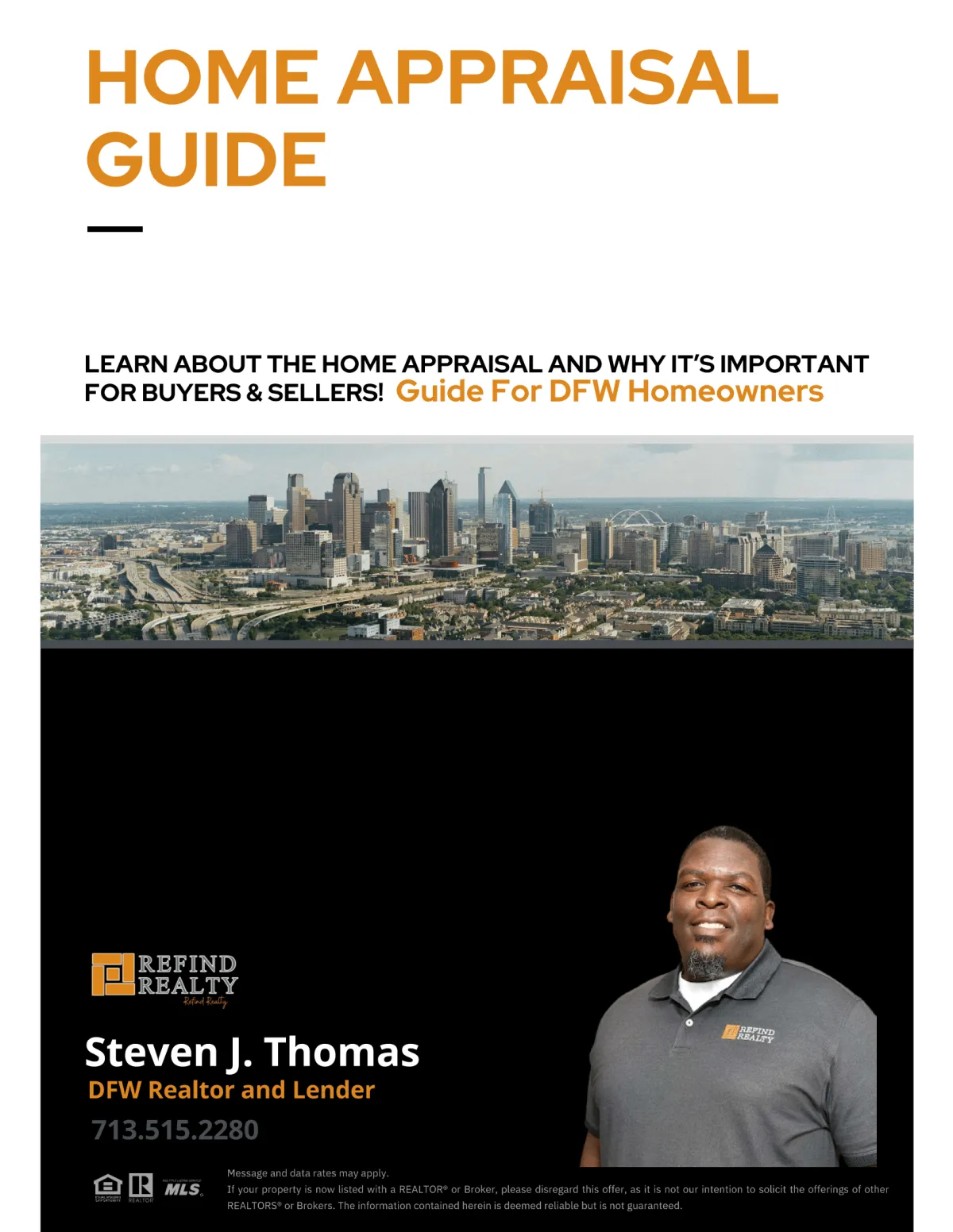You're Always At Home With Refind Realty.
Serving Your DFW Real Estate Needs Since 2005.
We Help You Buy and Sell in The Greater Dallas-Fort Worth Area.
Check Out Our Social Media Channels!
Buying in DFW
Buying your first or next home should be a rewarding and exciting time in your life, and one that you look back on with fond memories.
Thinking Of selling?
The market has changed a lot and I'd love to show you the exact strategy I use to get sellers in DFW top dollar for their property.
Get Pre-Approved
Let me walk you through the entire pre-approval process so you know exactly how much home you can afford.
Sign Up For my
Email List
My emails are a great way to stay up-to-date with local news and real estate market trends, even if you're not currently in the market. So, come on and join me to stay in the loop!
affordability Calculator
Get pre-approved to know exactly how much house you can afford. Use this calculator to get a quick estimate. Contact me for assistance!
DFW New Construction
Discover the latest new home constructions in DFW and take advantage of the builder incentives that are available now.
Let's Make Your real estate Dreams Come True.

Newest Listings
Call Me Today At (713) 505-2280

Refind Realty Blog:


The Rise of Multigenerational Living in Dallas–Fort Worth: What Buyers Need to Know
The Rise of Multigenerational Living in Dallas–Fort Worth: What Buyers Need to Know in 2025
By Steven J. Thomas

More families in Dallas–Fort Worth are choosing to live under one roof. Whether it’s aging parents moving in, adult children staying longer, or families pooling resources, multigenerational living has become a major housing trend in North Texas. This shift is changing how homes are built, bought, and sold in 2025.
Direct Answer
Multigenerational living in Dallas–Fort Worth is on the rise as families look for affordability, convenience, and flexibility. Buyers often seek homes with secondary suites, dual kitchens, or flexible layouts that can support multiple generations comfortably. Sellers benefit by highlighting multigenerational potential, and buyers can explore new construction options that cater specifically to this trend.
Neighborhood Spotlights: Where Multigenerational Homes Are in Demand
Frisco
Frisco has become a hub for new construction with flexible floor plans. Communities near top-rated Frisco ISD schools offer spacious layouts, bonus suites, and easy access to major employers. Many new builds in Frisco are designed with private entrances for in-laws or adult children. See updated neighborhood reports for Frisco.
Mansfield
Mansfield appeals to multigenerational buyers with its blend of affordability and lifestyle perks. The area offers newer homes with larger square footage, top schools, and proximity to both Dallas and Fort Worth job centers. Builders here are offering dual-owner suite plans that fit perfectly with the trend.
Prosper
Prosper attracts families looking for both luxury and functionality. Many of the master-planned communities include multigenerational layouts with casitas or separate living quarters. Easy access to Hwy 380 and the Dallas North Tollway makes it convenient for extended families.
Local Market Trends (Fall 2025)
As of October 2025:
Median Home Price: $430,500 (+2.4% YoY – Source: Texas A&M Real Estate Research Center, Sept 2025)
Average Days on Market: 41 days
Inventory: 3.1 months
Mortgage Rates: 6.6% (Freddie Mac PMMS, Sept 2025)
Multigenerational buyers are helping keep demand steady even with higher interest rates. According to the National Association of Realtors, nearly 1 in 6 buyers nationwide is now purchasing with multigenerational needs in mind.
“Multigenerational living isn’t just a trend—it’s becoming part of the DFW housing identity,” notes Dr. Luis Torres, economist with Texas A&M Real Estate Research Center.
Cost Breakdown for Buyers & Sellers
Staging for Flexibility: $800–$1,500 (highlighting dual-use rooms)
Renovations: Converting a den into a suite costs $10k–$25k
Closing Options: Rent-back periods may appeal to families coordinating multiple moves
Competition: Builders offering multigenerational layouts give buyers strong leverage
For sellers, investing in small upgrades like a kitchenette or privacy door can create a significant ROI in today’s market.
Builder & Community Insights: Know the Competition
New construction in suburbs like Frisco, Mansfield, and Prosper is directly targeting multigenerational families.
Top builders including Lennar, Highland Homes, and Perry Homes offer:
Private in-law suites
Casitas or guest houses
Multi-level owner suites
These builders often promote incentives like closing cost credits. Buyers should also explore the New Construction Homes Rebate Program for added savings.
Financing & Incentives That Attract Buyers
Many lenders now offer loan programs that consider combined family incomes, making multigenerational purchases more attainable. Buyers should get ahead of the competition with a mortgage pre-approval.
Expert tip: “Families who secure financing early often have more negotiating power when facing builder incentives,” says local mortgage consultant Amber Vance.
Flexible possession dates and seller credits remain key tools to compete against builders offering multigenerational layouts.
Conclusion
Multigenerational living is reshaping Dallas–Fort Worth real estate in 2025. Buyers want space, privacy, and flexibility, while sellers who position their homes with these features can capture strong demand.
Next steps:
Start by checking your Home Seller Score
Explore rebates and incentives through the New Construction Homes Rebate Program
Download the Lone Star Living App to view homes with multigenerational layouts
Book an appointment today.
You’re Always Home with Steven J. Thomas.
Key Takeaways
Multigenerational living is growing across Dallas–Fort Worth in 2025
Homes with dual suites, casitas, and flexible layouts are in demand
Frisco, Mansfield, and Prosper lead in multigenerational options
Sellers can highlight flexible spaces to attract more buyers
Buyers should secure financing and explore rebates to compete
FAQ: Multigenerational Living in Dallas–Fort Worth
What is a multigenerational home?
A home designed to accommodate multiple generations, often with private suites, kitchens, or entrances.
Why is multigenerational living growing in DFW?
High housing costs, cultural preferences, and convenience are driving more families to live together.
Do new construction homes offer multigenerational layouts?
Yes, many builders in Frisco, Mansfield, and Prosper now design homes with separate living quarters.
How do I finance a multigenerational home?
Consider combined household income or specialized loan products. Start with a pre-approval.
Is it smart to sell a home with multigenerational features?
Yes—homes with flexible layouts appeal to a wider pool of buyers.
Where can I search for homes with family-friendly layouts?
Download the Lone Star Living App for homes near schools and communities with multigenerational options.
Stay Informed With My Downloadable
Buyer and Seller guides

6 Smart Ways to Build Home Equity

7 Insider Secrets To Selling Your Home w/o a Lot of Time or Money

DFW Home Seller Negotiation Secrets

Home Appraisals Guide

Avoiding Pitfalls That Can Derail Your Home's Sale

Ultimate Guide To Buying a Home

A First Time Homebuyers Guide In DFW

Are You Ready To Buy?

25 Insider Secrets To Buying A Home

How to Improve Your Credit
Download All My Guides For Free
(I'll send you all 10)


Owned and Operated by Thomas & Thomas Financial Group, LLC
Steven J. Thomas
Steven J. Thomas has been in the financial services industry for the past 19 years and started my career as a Financial Planner for American Express Financial Advisors. I entered into banking with JP Morgan Chase as personal banker in 2003 and was promoted several times up to Small Business Specialist. I earned multiple Million Dollar Club awards and was ranked in the top 5 Small Business Specialist before I branched out in 2005 to start my own Financial Management Company. I ran a successful company before family circumstances lead me to Wachovia Bank in 2008 where I worked as a Senior Financial Specialist. As a Sr. Financial Specialist; I was responsible for the P & L and revenue growth of my banking center. The elimination of my role thru a bank merger lead me to BBVA Compass. I have held various leadership roles at BBVA Compass including Personal Relationship Manager, Branch Retail Executive, Workplace Solutions VP, and his current role as a Retail Manager. As the Regional Workplace Solutions VP, I was responsible for the strategic, tactical, and execution of Partnership Banking relationships, promotion and activity with corporate and non-profit companies in my footprint. I was responsible for the acquisition production for three districts, which includes 51 banking centers and over 300 employees. In May of 2014, I joined the team at Refind Realty and became one of the managing partners in mid-2015.

Wondering What Your DFW Home Could Be Worth in April 2024?
Get a Professional Home Valuation From A Local Market Expert
Unlock insights into potential selling prices.
Get a personalized analysis sent directly to your inbox.
Stay ahead with updates on property value fluctuations.
Benchmark your property against neighborhood listings.
Get a FREE Home Valuation And Potential Net Sheet:


I used this realtor and it was a great experience. He was patient and very helpful with our journey. He also helped us find a great lender with little hassle on the process, also got us approved for well above the market of our original home so we were able to get more house with a lower mortgage rate. So to anyone who is interested in buying a home take my advice give Steven a call. It’s worth it 😁
Bryant Loring


Steve was absolutely amazing! Everything was easy! Very professional in all aspects. Punctual, responsive, and diligent. He goes above and beyond to ensure you get to see as many homes as you’d like no matter the location. Not only was he knowledgeable about home buying, he also has a resourceful network for new home owner needs. I recommend Refind Realty to everyone!
Nicholas Bishop


I definitely recommend Steven to assist with your home buying needs. As a first time home buyer the process can be overwhelming, but as my realtor he was knowledgeable & patient while addressing my concerns and assisting me with my new home purchase. Thanks again Steven!! :-)
Gayle Mason

Ask Us Anything
Frequently Asked Questions
Why do you need a Realtor?
When buying or selling a home, there are so many options…which can also present a lot of obstacles. Laws change, forms change, and practices change all the time in the real estate industry. Because it’s our job to stay on top of those things, hiring a realtor reduces risk, and can also save you a lot of money in the long run.
When you work with me as your Realtor, you’re getting an expert who knows the area; knows how to skillfully guide your experience as a seller or buyer; can easily spot the difference between a good deal and a great deal. My job is to translate your dream into a real estate reality, and I work hard to earn and keep my business. This also means earning your trust: When you work with me, you’ll be working with a realtor who looks out for your best interests and is invested in your goals.
Which loan should you choose?
There are two different types of loans conventional loans and government-backed loans. The main difference is who insures these loans:
1 - Government-backed loans (FHA, VA and USDA):
(a) - Are, unsurprisingly, backed by the government.
(b) - Include FHA loans, VA loans, and USDA loans.
(c) - Make up less than 40 percent of the home loans generated in the U.S. each year.
2 - Conventional loans
(a) - Are not backed by the government.
(b) - Include conforming and non-conforming loans (such as jumbo loans).
(c) - Make up more than 60 percent of the loans generated in the U.S. each year.
What is the difference between FHA, VA and USDA loans?
1 - FHA LOANS:
FHA loans, which are insured by the Federal Housing Administration, are typically designed to meet the needs of first-time homebuyers with low or moderate incomes. FHA loans can be approved with a down payment of as little as 3.5 percent and a credit score as low as 580.
FHA loans are often called “helper loans,” because they give a leg up to potential borrowers who may not be able to secure one otherwise. For this reason, FHA loans have maximum lending limits, which are determined based on housing values for the county where the for-sale home is located.
Because the agency is taking on more risk by insuring FHA loans, the borrower is expected to pay mortgage insurance both at the time of closing and on a monthly basis, and the property must be owner-occupied.
2 - VA LOANS:
VA loans are backed by the Department of Veterans Affairs and they are guaranteed to qualified veterans and active-duty personnel and their spouses. VA loans can be approved with 100 percent financing, meaning VA borrowers are not required to make a down payment.
Unlike FHA loans, borrowers do not have to pay mortgage insurance on VA loans.
3 - USDA LOANS:
You may also hear about USDA loans, which are backed by the United States Department of Agriculture mortgage program. USDA loans are intended to support homeowners who purchase homes in rural and some suburban areas. USDA loans do not require a down payment and may offer lower interest rates; borrowers may have to pay a small mortgage insurance premium in order to offset the lender’s risk.
What’s a conventional loan? Understanding what it means to be conforming and non-conforming
Buyers who have a more established credit history and a larger down payment may prefer to apply for a conventional loan. These loans may offer a lower interest rate and only require the home buyer to purchase monthly mortgage insurance while the loan-to-value ratio is above a certain percentage, so a conventional loan borrower can typically save money in the long run.
Conventional loans are divided into two types: Conforming loans and non-conforming loans.
1 - CONFORMING LOANS:
Conforming loans are those that meet (or conform to) predetermined standards set by Fannie Mae and Freddie Mac — two government-sponsored institutions that buy and sell mortgages on the secondary market. By selling the loans to "Fannie and Freddie," lenders can free up their capital and return to issue more mortgages than if they had to personally back every loan that they approve.
The main standard for conforming loans is that the amount borrowed must be under a certain amount; in Alaska, a single-family home loan must be under $647,200 in order to be considered conforming.
Properties with more than one unit have higher limits.
2 - NON-CONFORMING (JUMBO) LOANS:
But what happens if a borrower wants to borrow more than the Freddie- and Fannie-approved loan amount? In this case, they would have to apply for a “jumbo loan,” which is the most common type of non-conforming loan.
Because the lender cannot resell the jumbo loan (or any non-conforming loan) to Freddie Mac or Fannie Mae, jumbo loans are considered to be riskier than a conforming loan. To protect against this risk, the bank will typically require a higher down payment; the interest rate on a jumbo loan may also be higher than if the same borrower applied for a conforming loan.
What kind of rate should you choose?
Rate types: Fixed-rate vs. adjustable-rate mortgages.
In addition to the loan type you choose, you’ll also have to determine if you want a fixed-rate mortgage or an adjustable-rate mortgage (ARM). A fixed-rate mortgage has an interest rate that does not change for the life of the loan, so it provides predictable monthly payments of principal and interest.
An adjustable-rate mortgage typically offers an initial introductory period with a low-interest rate. Once this period is over, the interest rate adjusts periodically, based on the market index. The initial interest rate on an ARM can sometimes be locked in for different periods, such as one, three, five, seven, or 10 years. Once the introductory period is over, the interest rate typically readjusts annually.
Office 1229 E. Pleasant Run Ste 224, DeSoto TX 75115
Call :(713) 505-2280
Email: [email protected]
Site: www.stevenjthomas.com

Facebook
Instagram
X
LinkedIn
Youtube
TikTok